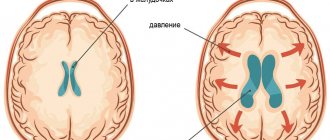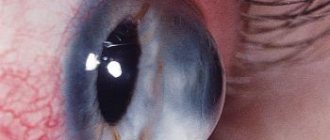Date of article writing: 09/21/2020 Quantity
()
Causes Types of astigmatism Symptoms and diagnosis of astigmatism Development of pathology Treatment Laser correction Hardware treatment (physiotherapy) Glasses and contact lenses Eye exercises Complications
Astigmatism is a refractive error caused by disturbances in the refraction of light waves in the optical system. It is often combined with other optical disorders - farsightedness or myopia.
Can astigmatism be cured?
What correction methods are the most effective? Why does pathology develop? What are the consequences of lack of therapy?
Astigmatism - what is this pathology?
Translated from Latin, this word means “absence of a focal point.”
The name helps to understand what astigmatism is: it is a distortion of the image due to defocusing of optical rays passing through the eye apparatus. A healthy eye has a smooth, spherical surface of the cornea and lens. They are curved equally in all directions, allowing the eye to focus light and transmit a clear image to the retina.
What is astigmatism?
? In this condition, the sphericity of the cornea and, less commonly, the lens is impaired. Because of this, the refractive power on different parts of the surface is different, and optical rays are distorted. As a result, the image appears blurry or disproportionate.
Depending on what additional refractive errors are complicated by astigmatism, there are several types of it:
- Simple hyperopic: farsightedness in one main meridian and normal visual functions (emmetropia) in the second.
- Simple myopic: myopia in one main meridian and emmetropia in the other.
- Complex hyperopic: farsightedness is observed in both main meridians.
- Complex myopic: myopia in two main meridians.
- Mixed: a combination of farsightedness in one meridian and myopia in another.
Types of refractive errors
An astigmatic eye has two main mutually perpendicular meridians. One refracts the light beam more strongly, the second - weaker. The location of the eye meridians determines the variant of the existing astigmatism, namely:
- The direct type (stronger refraction in the vertical meridian) is recorded most often.
- Reverse ( increased refraction in the horizontal meridian) – is observed infrequently and causes a lot of discomfort to the patient.
- A defect with oblique axes is characterized by an inclined arrangement of the main meridians.
How does astigmatism affect vision?
We are all well aware of the concepts of myopia and farsightedness, when problems arise with the perception of objects at close or far distances. What is eye astigmatism and how does it affect vision? People suffering from this pathology see a distorted picture. Some areas (or all objects) may be blurry, while others may be out of proportion. Ophthalmologists like to draw an analogy with a reflection on a metal spoon: the picture is sometimes unclear, sometimes disproportionate. In this case, it absolutely does not matter at what distance the object is located.
The level of distortion of objects is influenced by the severity of the pathology. When the difference in meridians is less than 1 D (diopter), the distortions are almost invisible and do not cause discomfort to a person. In general, ophthalmologists distinguish three degrees of astigmatism:
- weak - up to 3 D;
- average - 3-6 D;
- high - more than 6 D.
A weak degree usually requires minimal correction. With moderate vision deterioration becomes noticeable, the outlines of objects “float”, treatment of astigmatism is necessary. A high degree is characterized by severe distortion of objects and a number of accompanying symptoms associated with increased visual fatigue: pain in the eyes, headaches, dizziness, double objects.
Here is a photo that shows what it is - eye astigmatism and how a person with such a pathology sees.
Contact lenses and astigmatism
According to the majority of ophthalmologists and patients themselves, contact lenses are the most practical and effective in correcting astigmatism. Despite the fact that they are selected using almost the same system as cylindrical ones, the presented models have a number of significant advantages over glasses.
- Firstly, they provide more effective vision correction, since there is no distance between the cornea itself and the lens, while when wearing glasses it is about 10 mm.
- Secondly, the lenses provide not only central, but also peripheral vision, which allows you to clearly see objects located on the sides;
- Thirdly, the lenses can be worn in any weather, they do not fog up during rain or snow, and also do not draw attention to your visual impairments.
To correct this disorder, both lenses developed on the basis of soft polymers and those based on hard ones can be used. As a rule, the latter types are made exclusively to order. Finding them in the public domain is almost impossible. Among soft contact lenses today, the following models are especially popular:
- Air Optix for Astigmatism;
- 1-Day Acuvue Moist for Astigmatism;
- Acuvue Oasys for Astigmatism with Hydraclear Plus;
- Biomedics Toric;
- Biofinity Toric;
- PremiO Toric.
When creating toric lenses, manufacturers pay great attention to the method of fixing them on the cornea. The most common is the use of ballast, the essence of which is that a certain seal is formed in a certain area of the optical product. When gravity is applied, it will pull this edge down, causing the lens to remain in the same position all the time.
Another, no less popular method is cutting off the edge of the lens. As a rule - the lower one. However, this method is far from ideal and is practically not used by modern manufacturing companies. This is due to the fact that the lens itself can easily become detached during blinking and get lost, both in the eye itself and outside it. The most reliable method is periballast, a more advanced technology of conventional ballast. In this case, small bulges are created simultaneously in the upper and lower edges of the contact lens, thereby increasing its level of stability on the eye. Remember that optical products should only be selected by a qualified specialist, and therefore do not self-medicate by buying lenses on the advice of friends or acquaintances.
Why does astigmatism occur?
Astigmatism can be congenital or acquired. Let's look at the reasons why this disease manifests itself.
| Congenital astigmatism | Acquired astigmatism |
| The cause is hereditary genetic changes that provoke disturbances in the sphericity of the lens or cornea of the eye: uneven development of the bones of the orbit, disruption of the eye muscles, etc. Congenital astigmatism can occur in albinos, children with congenital retinitis pigmentosa, as well as in fetal alcohol syndrome. | Acquired astigmatism manifests itself as a result of:
|
Can people with astigmatism join the army?
Young people, whose turn has come to repay their debt to their homeland, are very often concerned with the question of whether eye astigmatism is an obstacle to serving in the army. It is impossible to answer this question unequivocally, since everything depends on the exact degree of impairment diagnosed in a particular conscript. As a rule, young people with a mild form of astigmatism fall under category B. However, there are some nuances here. Only vision from 2 to 4 diopters is taken into account. With such vision, a conscript is obliged to serve, but in certain troops.
If the degree of violation is weak, then such a young man is fit to serve in the army, but they have the right to call him fit only during military operations. But even here, not everything is so simple. A medical examination must be completed every three years. If during this time the medical board finds that the conscript’s visual functions have improved, he will receive category B and go to serve. Those young people whose vision is plus or minus 6 diopters and above will not be accepted into the army.
Symptoms of astigmatism
The first signs of astigmatism
appear in childhood. Unfortunately, kids can rarely formulate problems and explain that they are experiencing discomfort. That is why children are required to undergo examinations from the first months of life.
The main manifestation of eye astigmatism is blurred vision and blurred vision. In addition, the following symptoms may indicate pathology:
- increased eye fatigue;
- headache with visual stress;
- sensation of a foreign object in the eye;
- doubling of objects;
- burning, painful sensations in the eyes;
- difficulty maintaining attention;
- problems with visually determining the distance to objects.
Children's performance is falling.
They have difficulty reading and writing, confusing letters and numbers that are similar in spelling. It is especially important to identify astigmatism in time in children. If vision is not corrected promptly, amblyopia, or “lazy eye,” may develop. Due to the fact that during the early development of vision there is inadequate stimulation of the visual system (a constantly “blurred” picture), unequal refraction is formed, structural changes occur in the parts of the eyes and a significant decrease in vision that cannot be corrected is observed.
Various disease defects
Our eye refracts light fluctuatingly. This is explained by its anatomical structure, physiology and functions of refractive media. Normal physiological astigmatism is considered to be a deviation from the norm of up to 0.34 diopters. This condition does not impair vision, does not tire the eyes, does not cause headaches, double vision or asthenopic symptoms. Each of us can have this astigmatism.
A pathological defect, on the contrary, causes a lot of discomfort and is unfavorable for children. If it is not treated in time, the baby may develop strabismus or the so-called “lazy eye,” which cannot be corrected.
Diagnosis of astigmatism
In ophthalmology
Several methods are used to diagnose
astigmatism
. The most revealing is refractometry: an analysis of the refractive power of the eye, which allows us to identify refractive errors. Another popular method is visometry, a familiar vision test using tables. It is performed first without correction, and then with correction, when cylindrical lenses with different refractive powers are placed in front of the eye. Skiascopy, or the shadow test method, also helps identify problems: the patient is allowed to “try on” spherical and cylindrical lenses, and the doctor observes the movements of the shadows on the pupillary area.
The following may also be prescribed:
- Ultrasound of the eyeballs;
- computer keratotopography;
- ophthalmometry;
- autorefractometry and other methods.
Causes of pathology
There are two types of astigmatism - lenticular and corneal. The first occurs due to a defective shape of the lens, its partial or complete ectopia. The reason for the second pathology lies in the irregular shape of the cornea, which does not allow the rays to be focused at a certain point on the retina. In this case, a person sees blurry images of objects.
If the refractive power of the cornea is about 43 diopters, then the lens has only 19 diopters. Since the cornea is more important in the refraction (refraction) of rays, distortion of its configuration usually causes astigmatism.
Common causes of the disease are:
- Heavy heredity . A congenital disease is usually formed at the gene level if parents have the same problem. Astigmatism, caused by a defect in the genetic code, is diagnosed in early childhood.
- Inflammation of the eyes . Most often, curvature of the cornea occurs due to keratitis, which disrupts the structure of the membrane, causing deformations and opacities. This impairs the refractive power of the eyes.
- Injuries . Superficial and penetrating injuries to the apple often cause dislocation (subluxation) of the lens, scratches and ruptures of the cornea. Scars form on the shell, changing its shape. A person develops unilateral, usually irregular, astigmatism.
- Degeneration and dystrophy of the cornea . Such diseases distort the standard shape of the sclera. In its normal form it should be a clear hemisphere, but with defects (keratoconus, keratoglobus, etc.) it becomes curved or uneven.
- Surgical interventions . Treatment accompanied by an incision of the cornea often causes deformation of the latter. The reason for this is incorrectly applied, frayed sutures, and their removal ahead of time.
How to treat astigmatism
Can astigmatism be cured? Yes, conservative and surgical methods are used for this. Let's look at each of them in more detail.
Optical correction of astigmatism
Glasses have been used for the longest time to correct astigmatism - this method has been used for more than 40 years. Glasses can have cylindrical or spherocylindrical lenses. Doctors determine the exact direction of the eye meridians, the degree of astigmatism, and associated refractions (myopia, farsightedness). Can astigmatism be treated with glasses? No, they only improve your vision while they are worn. Glasses have several disadvantages: they do a good job of correcting the image if a person is looking straight, but when the direction of gaze shifts, the image is distorted again. This can cause dizziness, nausea, and increased eye fatigue.
Using contact lenses is a more advanced method than wearing glasses. They fit tightly to the cornea, so they completely avoid distortion and correct vision not only in the center, but also in the periphery. Soft toric contact lenses are commonly used to correct astigmatism. Leading manufacturers: Alcon, Cooper Vision, iWear. You can view the catalog and study prices for such contact lenses in our catalog.
Surgical correction of astigmatism
For the treatment of astigmatism in adults
Today, laser vision correction is most often recommended. This procedure allows for a keratotomy - removing part of the cornea and reducing its refractive power - using high-precision lasers. The procedure is performed under local anesthesia and has virtually no complications.
If the cause of the pathology is deformation of the lens, surgery is performed to replace it. How is astigmatism treated in adults
in this manner? After a detailed examination, the ophthalmologist makes intraocular lenses (IOLs) that replace the damaged lens. Different types of IOLs can be used - toric, multifocal, phakic.
Another treatment method is thermokeratocoagulation: burning the cornea with a metal needle or laser beam. The thickness of the corneal tissue is reduced in the center of the optical zone or at the periphery. This allows you to increase the refractive power of the cornea.
For surgeries for astigmatism
there are
contraindications
. Thus, surgical intervention is impossible in case of retinal pathologies, problems with the cornea, some eye diseases (cataracts, glaucoma), in the presence of infectious diseases, diabetes mellitus, oncology, tuberculosis, during pregnancy and lactation.
Laser therapy
For irregular astigmatism, these procedures are prescribed for those who do not want to wear optics. Laser correction is carried out at the request of the patient and is the most popular method of surgical treatment of vision defects.
Contraindications for refractive surgery:
- Serious retinal damage;
- Decompensated diabetes mellitus;
- Eye inflammation, glaucoma or cataracts;
- Pregnancy and breastfeeding.
Laser therapy is very effective for patients with irregular astigmatism that cannot be corrected optically. The method will eliminate corneal defects and restore its standard configuration. After the operation, people begin to clearly see surrounding objects.
Prevention methods
Now that we have figured out how to cure astigmatism
, let's talk about how to prevent the development of pathology. It is necessary to visit an ophthalmologist regularly and have your vision tested to notice changes in the early stages. Gymnastics for the eyes will be useful: exercises will help relax the eye muscles, improve blood circulation and normalize metabolic processes.
To prevent astigmatism in children, it is worth making sure that the eyes are not overstrained: limit time with gadgets and monitor the correct position and light level during classes. Ophthalmologists also recommend regularly taking courses of multivitamins intended for the eyes.
Gymnastics for the eyes for astigmatism
Gymnastics for the eyes with astigmatism is also very important. Of course, it is impossible to perceive a set of certain physical exercises as an ideal panacea, since it is not possible to cure this pathology in this way. However, regular exercise can help relieve astigmatism. This is explained by the fact that with this visual impairment, a strain on the accommodation of the eye occurs, in other words, the refractive ability of the lens changes, depriving a person of the ability to clearly see the objects around him. In this regard, fatigue of the visual organs increases, especially if you are forced to spend a lot of time at the computer, pain occurs in the area of the eyes or temples.
Experts have developed special training programs that help reduce visual stress. Their effectiveness lies in the fact that when performing these exercises, the eye muscles rest and relax, providing the necessary level of accommodation of the lens. In addition, blood circulation improves and metabolic processes are normalized. Ophthalmologists recommend their patients to perform eye exercises at least three times during the day, and if your work involves a computer, then at least every hour.
What exercises do experts recommend doing in this situation?
- Close your eyes as tightly as possible for at least five seconds. This improves blood flow to the eyes and thereby speeds up metabolism in the involved muscles of the visual organs.
- Go to the window and focus your vision on the glass, then find a point that is at the maximum distance and try to look at it for about 30 seconds. This will relax the ciliary muscles.
- Rotate your eyes clockwise and in the opposite direction at a slow pace for about 20 seconds. This helps activate the extraocular muscles.
What other methods of correcting astigmatism are there?
In cases where astigmatism is accompanied by farsightedness or myopia, another surgical method is used as an alternative to laser correction - installing an intraocular contact lens on the lens. Also, in some cases, tangential keratotomy, or correction of corneal pathology by incision, is indicated. Previously, this operation was carried out manually. Nowadays, a universal “scalpel” is used for this in the form of ultrashort laser pulses, which make a cut without heating or damaging surrounding tissues. Tangential keratotomy is the most accessible method of laser correction. In some cases, various implants are also used - astigmatic lenses - and special frames are installed to support the cornea (crosslinking and corneal rings).
What other correction methods are there?
- Intraocular contact lenses.
- Tangential keratotomy.
- Installation of implants (astigmatic lenses).
- Crosslinking and corneal rings.
Remember that only an ophthalmologist can correctly determine the treatment method after conducting a detailed examination of the patient’s visual system. Independently choosing a correction method can lead to worsening vision and serious adverse consequences for the eyes.
In the Ochkov.Net online store you can order high-quality lenses for astigmatism correction from world brands. We guarantee you ease of ordering and fast delivery of goods throughout Russia.
Treatment methods and their effectiveness
If the disease is not amenable to optical correction due to its complexity or neglect, surgery is prescribed after amblyopia is cured.
Farsighted astigmatism can be successfully treated with surgical methods:
- With laser thermokeratoplasty, the shape of the surface of the cornea undergoes changes: burns are applied in the peripheral area of the cornea using a point method using a laser, as a result of which collagen fibers are reduced and the shape of the surface of the cornea is adjusted in the desired direction.
- With thermokeratocoagulation, pinpoint burns are applied with a thin metal needle heated to a certain temperature.
- Laser keratomileusis is by far the most effective and safe method of surgery in the field of correction of optical defects. The excimer laser has been successfully used for two decades; it evaporates tissue of the required thickness from the surface layer of the cornea, changing its shape and degree of curvature.
Complex farsighted astigmatism is a rather serious pathology that requires long-term correction, but modern technologies make it possible to get rid of the problem forever and restore full vision.
Making an appointment Today: 24 registered







